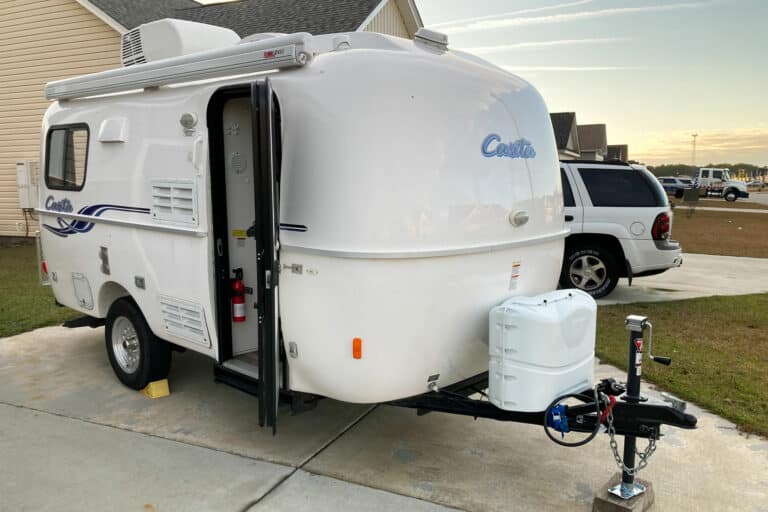Dear EarthTalk:
How can I measure—and then improve—my overall “carbon footprint?” What are the major areas of one’s daily life that one measures?
— Andy Fusco, Passaic, NJ
With global warming dominating so many headlines today, it’s no surprise that many of us are looking to reduce the amount of carbon dioxide and other greenhouse gases our activities produce.
By assessing how much pollution each of your individual actions generates—be it setting your thermostat, shopping for groceries, commuting to work or flying somewhere for vacation—you can begin to see how changing a few habits here and there can significantly reduce your overall carbon footprint. Luckily for those of us who want to see how we measure up, there are a number of free online carbon footprint calculators to help figure out just where to start changing.
One of the best is the University of California at Berkeley’s Cool Climate Calculator. The free web-based tool takes into account daily driving mileage and grocery and electricity expenses, among other factors, to assign a carbon score, which users can compare to similar households across the 28 largest urban areas in the U.S. Some of the results are surprising. For example, residents of eco-aware San Francisco tend to have bigger carbon footprints than those in more conservative Tampa, Florida. The reason: San Francisco has a higher cost of living and colder, wetter winters (requiring more fossil-fuel derived heat).
Another great carbon footprint calculator is available at EarthLab.com, an online “climate crisis community” that has partnered with Al Gore’s Alliance for Climate Protection and other high-profile groups, companies and celebrities to spread the word that individual actions can make a difference in the fight against global warming. Users just take a three-minute survey and get back a carbon footprint score, which they can save and update as they work to reduce their impact. The site provides some 150 lifestyle change suggestions that will cut carbon emissions—from hanging your clothes to dry to sending postcards instead of letters to taking the bike instead of the car to work a few days a week.
“Our calculator is an important first step in educating people about where they are, then raising their awareness about what they can do to make easy, simple changes that will lower their score and positively impact the planet,” says Anna Rising, EarthLab’s executive director. “Our goal isn’t about convincing you to buy a hybrid or retrofit your house with solar panels; our goal is to introduce you to easy, simple ways that you as an individual can reduce your carbon footprint.”
Other websites, green groups and corporations, including CarbonFootprint.com, CarbonCounter.org, Conservation International, The Nature Conservancy and British Oil Giant BP, among others, also offer carbon calculators on their websites. And CarbonFund.org even allows you to assess your carbon footprint—and then offers you the ability to offset such emissions by investing in clean energy initiatives.
CONTACTS: Cool Climate Calculator, www.berkeley.edu/calculator.html; EarthLab, CarbonFootprint.com, CarbonCounter.org, Conservation International, The Nature Conservancy, BP
———-
Dear EarthTalk:
Why are some environmental groups jumping on the immigration issue? What does immigration have to do with the environment?
— Ginna Jones, Darien, CT
What to do about booming legal and illegal immigration rates is one of the most controversial topics on Americans’ political agenda these days. More than a million immigrants achieve permanent resident status in the U.S. every year. Another 700,000 become full-fledged American citizens. The non-profit Pew Research Center reports that 82 percent of U.S. population growth is attributable to immigration.
Meanwhile, the U.S. Census Bureau estimates that U.S. population will grow from 303 million people today to 400 million as early as 2040. While many industrialized nations, including Japan and most of Western Europe, are experiencing population growth slowdowns due to below replacement birth levels and little immigration, the U.S. is growing so fast that it trails only India and China in total numbers.
Advocates for U.S. population stabilization, including some environmental organizations and leaders, fear that this ongoing influx of new arrivals is forcing the nation to exceed its “carrying capacity,” stressing an already overburdened physical infrastructure. David Durham of Population-Environment Balance says that Americans who care about the environment should insist on reducing immigration, to recognize “ecological realities such as limited potable water, topsoil and infrastructure.” He also cites studies showing that a permissive U.S. immigration policy drives up fertility rates in the sending countries “which is the last thing these sending countries need.”
To others the problem is larger than immigration itself. “People don’t just materialize at our border, or at any border,” says John Seager of Population Connection. “When you talk about immigration, you’re talking about the second half of a process that begins when people decide to leave their homes.” And they are usually leaving their homes because of hunger, lack of work, oppression, or any number of other often-desperate reasons. Seager and many others argue that by helping poor nations better address the economic and family planning needs of their citizens, Americans can not only help improve the lot of millions of people living in dire poverty, but also slow down the tide of immigration.
Groups focusing on the immigration-environment nexus are keen to get their voices heard, but many mainstream green groups shun the highly divisive topic, preferring instead to encourage Americans, who are infamous around the world for their huge homes, gas-guzzling cars and extravagant consumption habits, to curb their unsustainable lifestyles, which they see as more fundamental to U.S. environmental problems than population pressures. With just five percent of the world’s people, Americans use a quarter of the world’s fossil fuels, own more private cars than drivers with licenses, and live in homes that are on average 38 percent larger today than they were in 1975. By scaling back, Americans can take a big bite out of pollution, sprawl and other environmental problems, while also setting a good example for those who land in the U.S. every year, lowering the nation’s collective carbon footprint significantly in the process.
CONTACTS: Pew Research Center, Population-Environment Balance, Population Connection.
———-
GOT AN ENVIRONMENTAL QUESTION?
Send it to:
EarthTalk,
c/o E/The Environmental Magazine,
P.O. Box 5098,
Westport, CT 06881;
submit it at: www.emagazine.com/earthtalk/thisweek
or e-mail: [email protected].
Read past columns at:







